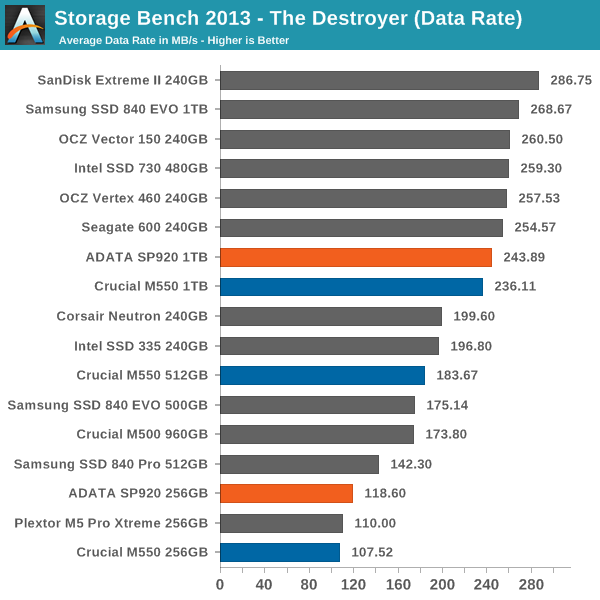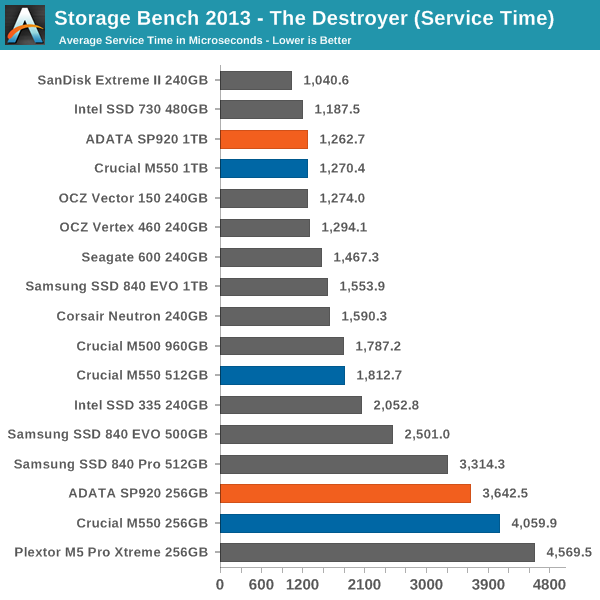ADATA SP920 (128GB, 256GB, 512GB & 1TB) Review
by Kristian Vättö on April 1, 2014 8:30 PM ESTAnandTech Storage Bench 2013
Our Storage Bench 2013 focuses on worst-case multitasking and IO consistency. Similar to our earlier Storage Benches, the test is still application trace based—we record all IO requests made to a test system and play them back on the drive we're testing and run statistical analysis on the drive's responses. There are 49.8 million IO operations in total with 1583.0GB of reads and 875.6GB of writes. I'm not including the full description of the test for better readability, so make sure to read our Storage Bench 2013 introduction for the full details.
| AnandTech Storage Bench 2013 - The Destroyer | ||
| Workload | Description | Applications Used |
| Photo Sync/Editing | Import images, edit, export | Adobe Photoshop CS6, Adobe Lightroom 4, Dropbox |
| Gaming | Download/install games, play games | Steam, Deus Ex, Skyrim, Starcraft 2, BioShock Infinite |
| Virtualization | Run/manage VM, use general apps inside VM | VirtualBox |
| General Productivity | Browse the web, manage local email, copy files, encrypt/decrypt files, backup system, download content, virus/malware scan | Chrome, IE10, Outlook, Windows 8, AxCrypt, uTorrent, AdAware |
| Video Playback | Copy and watch movies | Windows 8 |
| Application Development | Compile projects, check out code, download code samples | Visual Studio 2012 |
We are reporting two primary metrics with the Destroyer: average data rate in MB/s and average service time in microseconds. The former gives you an idea of the throughput of the drive during the time that it was running the test workload. This can be a very good indication of overall performance. What average data rate doesn't do a good job of is taking into account response time of very bursty (read: high queue depth) IO. By reporting average service time we heavily weigh latency for queued IOs. You'll note that this is a metric we've been reporting in our enterprise benchmarks for a while now. With the client tests maturing, the time was right for a little convergence.

Surprisingly the 256GB SP920 is faster than 256GB M550 even though the SP920 has fewer NAND dies. The main reason Crucial went with 64Gbit die for 128GB and 256GB models was increased performance, but it looks like that mainly applies the 128GB version. Of course, ~10MB/s isn't a big difference but it's still interesting that the performance hit from 128Gbit NAND is mostly a non-issue for the 256GB model.











30 Comments
View All Comments
Samus - Wednesday, April 2, 2014 - link
Marvell controllers are just simpler than Sandforce (which is a good thing)Marvell has eDrive support in their newer controllers, simpler firmware, lower power usage, and no compression technology (making the implementation simple and performance consistent)
I prefer Marvell and Intel controllers over everyone else's but some newer controllers have looked promising (like OCZ's Barefoot)
Kristian Vättö - Thursday, April 3, 2014 - link
Marvell only provides the silicon - the firmware development is up to the manufacturer.hojnikb - Wednesday, April 2, 2014 - link
It's interesting to see that lower capacity versions perform better than m500, despite using the same die size flash. Is this because of the updated controller or more aggressive flash programming ?Samus - Wednesday, April 2, 2014 - link
They have the m550 controller but use the m500's NAND technology so the lower capacity drives are in between the m500 and m550 in performance.Kristian Vättö - Thursday, April 3, 2014 - link
Likely just better optimization at the firmware level.hojnikb - Thursday, April 3, 2014 - link
So in theory, they could update the m500 and boost it's, if they wanted ?hojnikb - Thursday, April 3, 2014 - link
*write speed, silly me :)(damn no edit option)
nick2crete - Wednesday, April 2, 2014 - link
Well ,i prefer to deal with Crucial than Adata even overseas where i am ..Hubb1e - Wednesday, April 2, 2014 - link
I just wanted to let the writer and editorial staff know that a good number of people skip right to the end of the article for the normal recap of the article's main points. This is especially true for SSD articles which IMO are getting to be a commodity and aren't all that interesting anymore. I felt that the final words didn't do a good job of recapping where this drive stands in the overall SSD segment, didn't give much in the way of a pro/cons for this drive, and refereed too much to a comparison with a drive that I don't know much about. This seems like a new writer so I wanted to let the staff know about my opinion on this so he can improve his next article for Anandtech.mcnaughty - Wednesday, April 2, 2014 - link
Totally agreed. Skip the waffle, we regular readers know all this already. Give us the numbers, and the interesting differences.